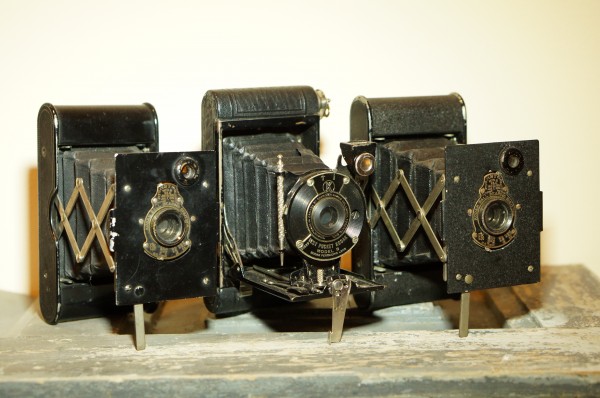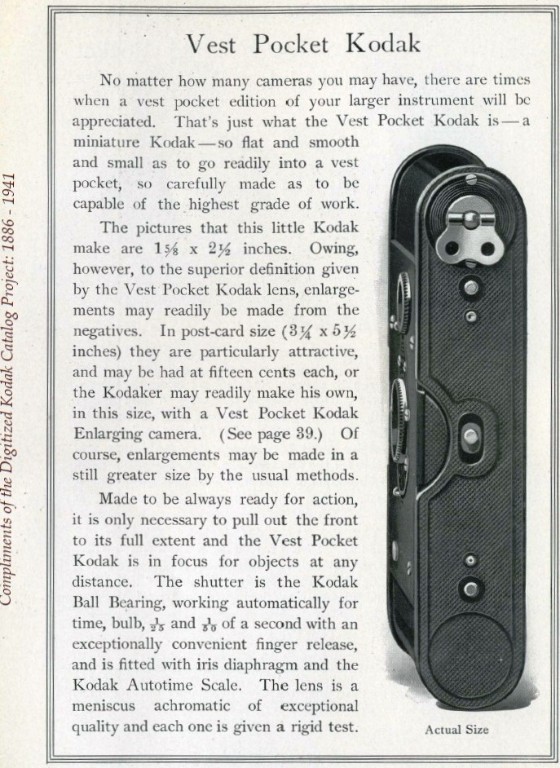These are “Vest Pocket Kodaks” – of which nearly two million were produced, from about 1912 to the early 1920s. I’ve blogged about one of these cameras before – to sum up, they represent an important step in the miniaturization of cameras, making them the first mass-produced cameras that could actually fit in a vest pocket. As such, they wound up in innumerable soldiers pockets in World War I, earning them the nickname “soldier’s camera.”
The cameras pictured here did not spend any time in World War I, as their serial numbers place them in the very late teens and/or (most likely) early 1920s, at the earliest. The two outer cameras have serial numbers on the backs of the little “feet” propping them up; the inner camera is a “model B”, produced well after the war. Unlike the very early models, they are “autographics” – meaning they have a little window in the back which could be opened, and, using a metal stylus (shown on the front of the middle camera but attached to the back of the others), the user could scratch some information about the shot on the back of the film, expose it to the light, and have that become a permanent part of the photo.
I have been struggling to get decent photographs out of all three of these cameras, and despite the sunny description in the ad above, it can be a challenge. The struts that fold out when you extend the bellows are a bit delicate, and it is easy to inadvertently use the camera without extending it fully. Also, the cover that is removed to allow film loading (facing you in the photo above) is held in place using the small switch in the middle – which is easily moved, allowing the cover to fall off and exposing all the film. Plus, with any camera nearly 100 years old, the leather bellows almost always have pinholes. They are tricky to detect and can be temporarily covered with electrician’s tape, but are best closed with a tiny bit of gasket material, or a mix of white glue, a drop of dish soap, and black coloring. Don’t bother trying to fix anything bigger than a tiny pinhole.
But after a number of attempts, I have managed to get pictures of some form from all three. They’re not going to win any prizes, but I find it amazing that a 100-year-old camera can produce photos at all. Will your DSL be able to do that in 20 years?
So going from left to right, here are my best photos so far. The far left camera was produced from 1915 to 1925, and this one, serial numbered 1053829, is most likely from 1919 or 1920. It clearly still has an undiagnosed light leak – but this is a good start. The second photo is a sideways shot of the temple room seen in the first shot.
The middle camera is the newest of the three. It was produced from 1925 to 1934 and was also marketed as the “Boy Scout” or “Girl Scout” camera. Instead of folding struts, this model uses a folding bed that opens up, and then the bellows portion slides forward. It can also be a bit tricky. The first time I took this one out for a spin, it had light leaks, which I have since repaired.
Finally, the camera on the right, which is actually the first one I acquired. This one, numbered 1237896 and acquired in South Africa, is most likely from 1920. The photos are from a construction site in Windhoek, Namibia – I thought the light and shadows would be a good way to see how it performs. The third photo is an accidental double exposure, which often happened back in the days when these were made.
If you’ve got one of these cameras and are wondering where you can get film, there are still a very few places that stockpiled 127 film and will still sell it to you for a pretty high price (in my opinion. It’s supply vs demand – not judging!) Another alternative is to buy a few 127 spools, use a sharp knife to cut down a roll of 120 film, and respool it in complete darkness. The slightly differing lengths may make the diameter of the roll slightly larger, which can cause a tight fit. Finally, I’m told there are also people who simply spool 35mm film onto the 127 spools. You end up with sprocket holes in your photos and you have to either use a 127 backing paper or tape over the red window.
Like all cameras, they can be used to tell stories. But imagine the stories these cameras themselves would have!












I have owned one of these since the ’70s but never deigned to load or use it. They are attractive conversation pieces, however. You are a good “Kodaker” 🙂
Thanks! these are amazing little contraptions!